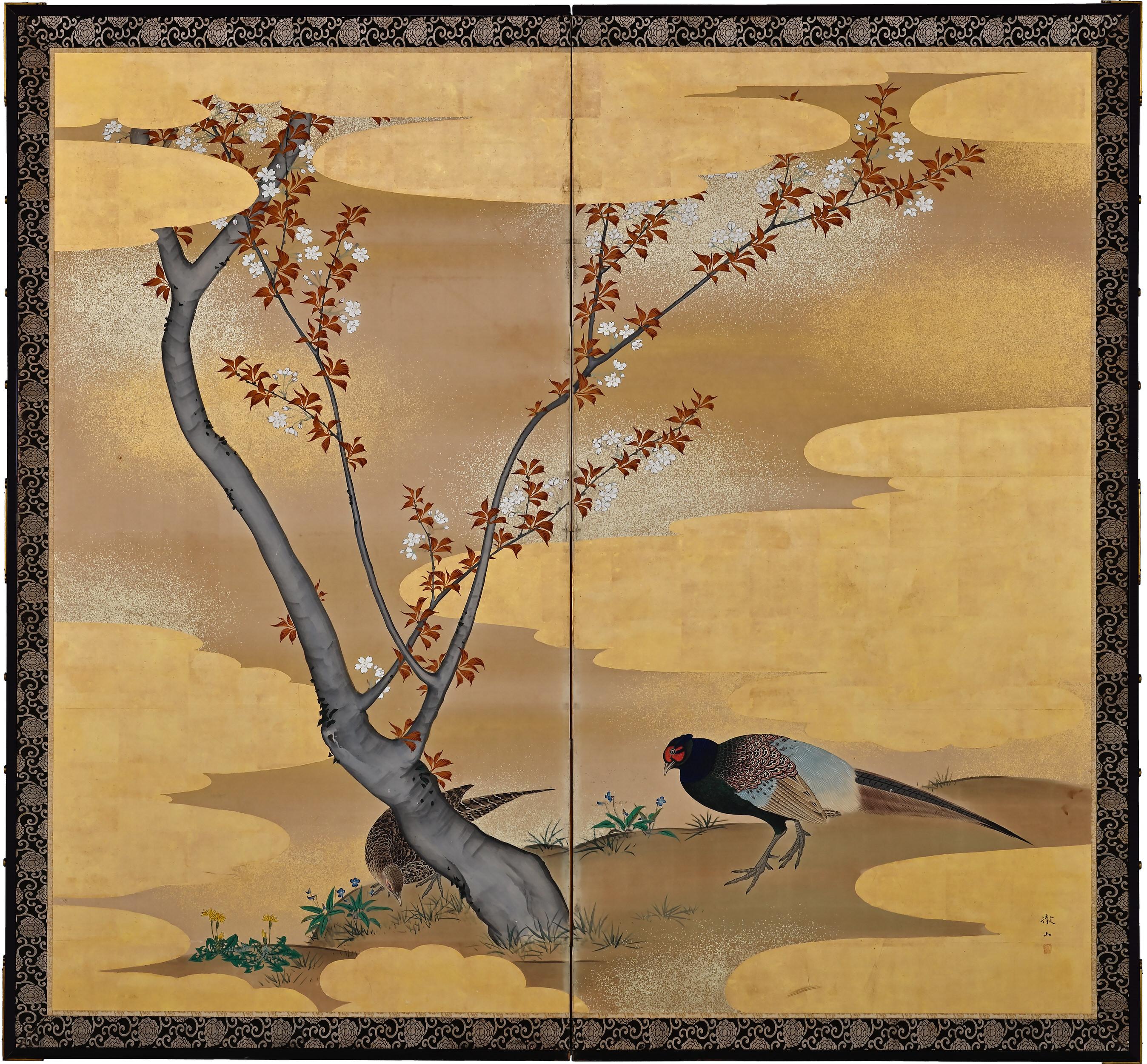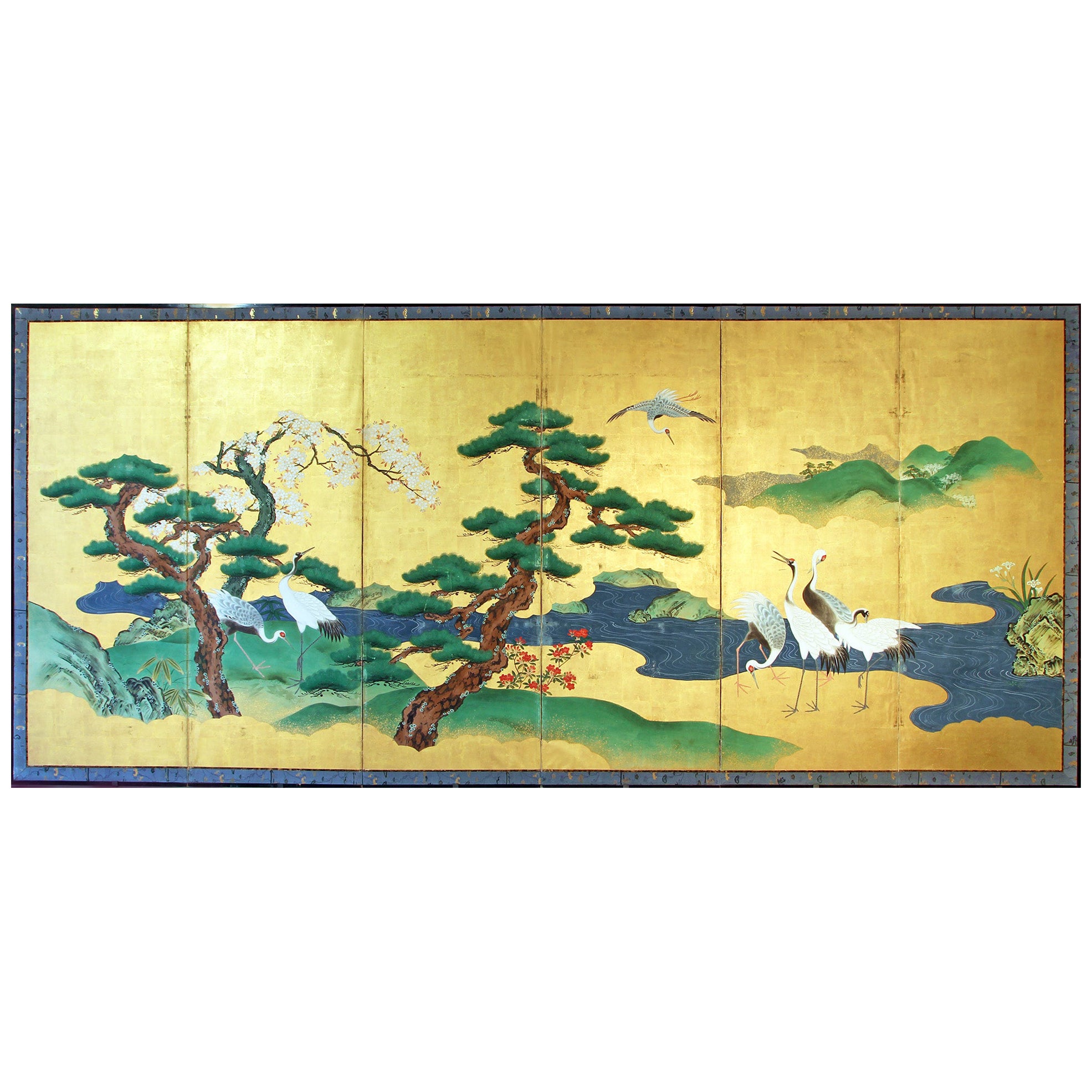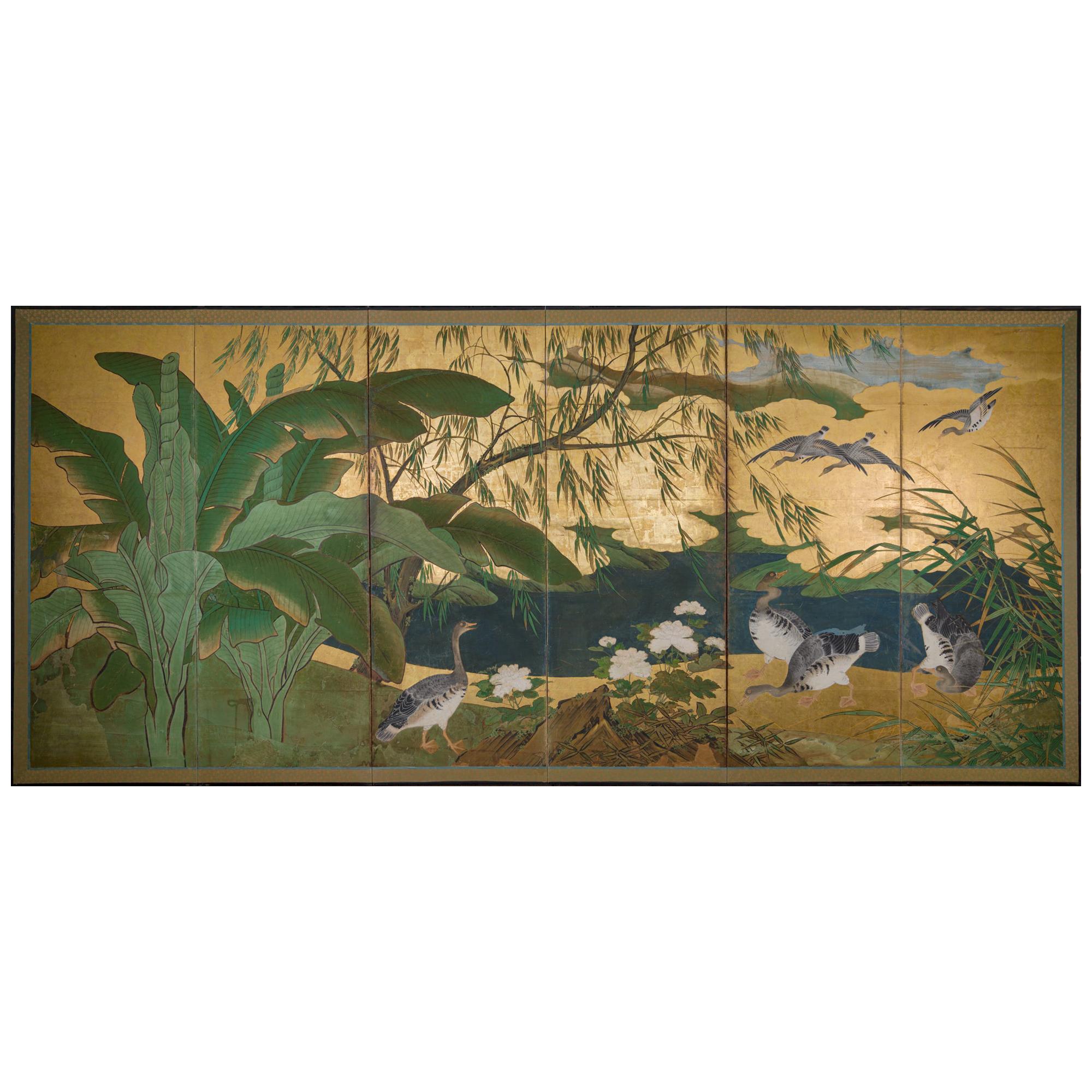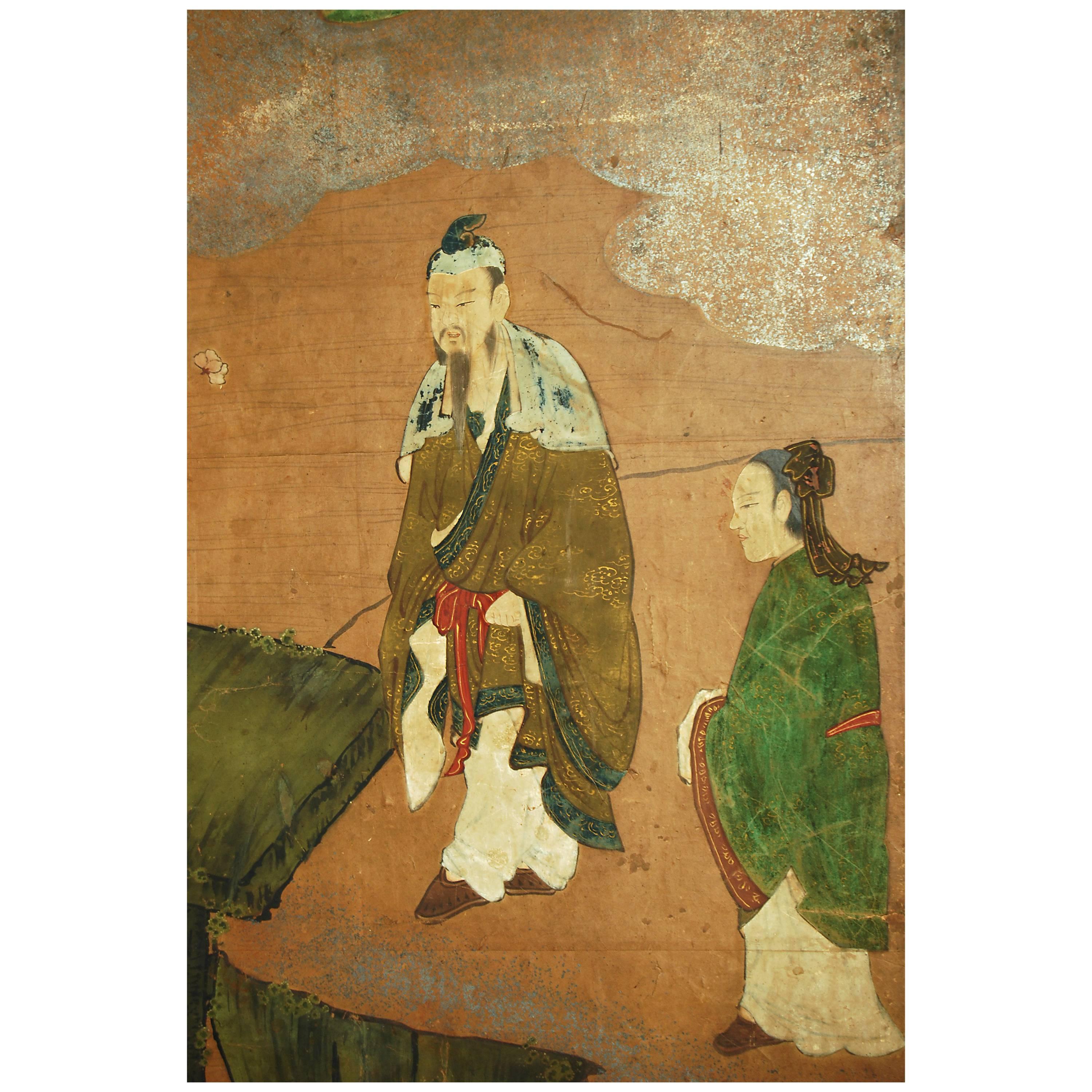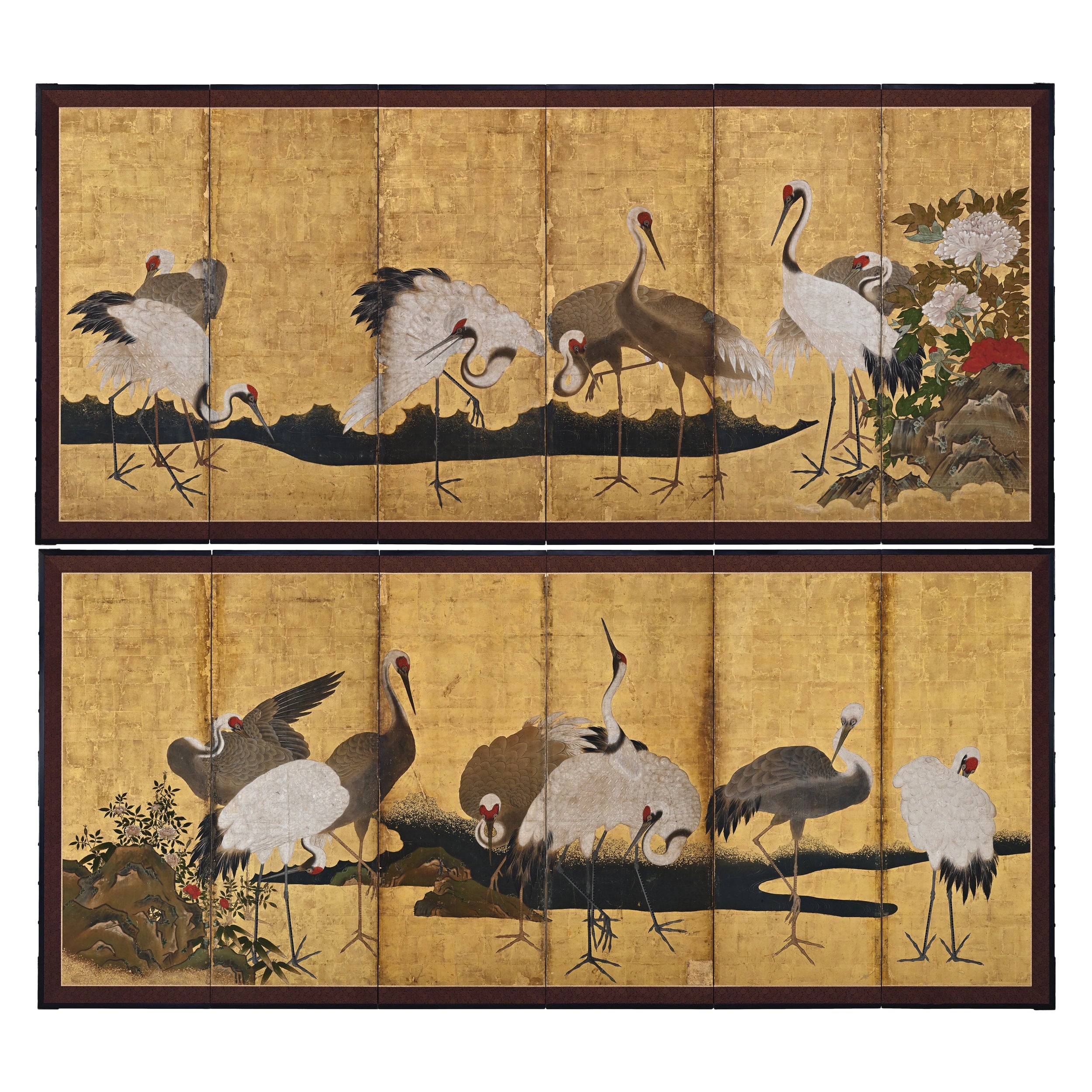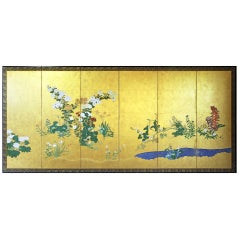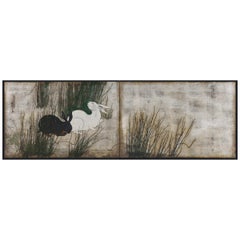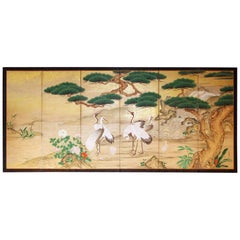
19th Century Japanese Landscape Folding Screen Rice Paper and Gold Specks
View Similar Items
Want more images or videos?
Request additional images or videos from the seller
1 of 9
19th Century Japanese Landscape Folding Screen Rice Paper and Gold Specks
About the Item
- Dimensions:Height: 66.93 in (170 cm)Width: 144.89 in (368 cm)Depth: 0.79 in (2 cm)
- Style:Edo (Of the Period)
- Materials and Techniques:
- Place of Origin:
- Period:
- Date of Manufacture:circa 1820
- Condition:Refinished. Minor losses. Minor structural damages. The item is 200 years old and some touch ups have been made. The screen is sold with special supports to be hung on the wall.
- Seller Location:Brescia, IT
- Reference Number:1stDibs: LU5628222733222
About the Seller
5.0
Recognized Seller
These prestigious sellers are industry leaders and represent the highest echelon for item quality and design.
Established in 1981
1stDibs seller since 2021
14 sales on 1stDibs
Typical response time: 7 hours
More From This SellerView All
- Edo Period 19th Century Japanese Folding Screen Six Panels Flowers on Gold LeafBy Rimpa SchoolLocated in Brescia, ITClouds of gold, water and many colorful flowers: Japanese six-panel folding screen by Rimpa School. Hand painted with rice mineral pigments and inks on rice paper and gold leaf.Category
Antique Early 19th Century Japanese Edo Paintings and Screens
MaterialsGold Leaf
- Japanese Folding Screen Six Panels Painted on Gold LeafBy Japanese StudioLocated in Brescia, ITParavento a sei pannelli di scuola giapponese Kano: paesaggio con bellissime ed eleganti gru vicino al fiume, con alberi di pino e sakura. Dipinto a mano con pigmenti minerali ed inc...Category
Antique Early 19th Century Japanese Edo Paintings and Screens
MaterialsGold Leaf
- Edo Landscape Japanese Folding ScreenBy Japanese StudioLocated in Brescia, ITRefined work by a painter from the first half of the 19th century, from the landscape of the "Rinpa" school by a painter from the end of the 18th century, the Rinpa school. Six panels painted in ink on gold leaf and "gofun" on vegetable paper. The flowers are made with the "gofun" technique, natural or pigmented white oyster powder. Rinpa is one of the major historical schools of Japanese painting. The style was consolidated by the brothers Ogata Korin (1658–1716) and Ogata Kenzan (1663–1743). This folding screen has a very clean design that leaves plenty of room for the beautiful golden landscape. It comes flat and you can easily hang it with our hooks. Lucio Morini...Category
Antique 18th Century Japanese Edo Paintings and Screens
MaterialsGold Leaf
- Six-Panel Japanese Screen on Spring Gold LeafLocated in Brescia, ITSpring landscape by an unknown painter of the Rinpa school, 19th century, six-panel ink painted on gold leaf on rice paper. The flowers are made with the "gofun" technique, natural or pigmented white oyster powder. Rinpa (? ?, Rinpa) is one of the major historical schools of Japanese painting. the style was consolidated by the brothers Ogata Korin (1658–1716) and Ogata Kenzan...Category
Antique Late 19th Century Japanese Edo Paintings and Screens
MaterialsGold Leaf
- Landscape with Flowers, Japanese Folding ScreenLocated in Brescia, ITSix-panel screen of the "Rinpa school", painted with inks on gold leaf. Colorful and sunny variety of flowers painted with great skill by an anonymous Japanese artist, who skilfully...Category
Antique Early 19th Century Japanese Meiji Paintings and Screens
MaterialsGold Leaf
- 20th Century Showa Period Beautiful Spring Garden Folding Screen Two PanelsLocated in Brescia, ITJapanese screen with two doors painted with mineral pigments on rice paper. Early Showa period.Category
Late 20th Century Japanese Showa Paintings and Screens
MaterialsPaper
You May Also Like
- 19th Century Japanese Edo Six Panel Kano School Landscape ScreenLocated in Rio Vista, CALate Edo period 19th century Japanese six-panel landscape screen featuring a cypress tree over a flowering hibiscus with a pair of hototogisu birds. Kano school painted with ink and ...Category
Antique 19th Century Japanese Edo Paintings and Screens
MaterialsSilk, Wood, Paper
- 19th Century Small Japanese Screen Pair, Pine Trees and Vines on Gold LeafLocated in Kyoto, JPThis pair of screens depict just the middle sections of aged pine trees, painted in bold brush strokes on a background of gold leaf clouds. The trees are draped in vines, the lush cr...Category
Antique Mid-19th Century Japanese Edo Paintings and Screens
MaterialsGold Leaf
- Japanese Screen, 19th Century, Rabbits and Horsetail Reeds on Silver LeafBy NenmaLocated in Kyoto, JPUnknown artist Rabbits and Horsetail Reeds Painted in the Year of the Fire Dog, 1826 or 1886. 19th century. The scene depicted here is set under moonlight, with two hares hi...Category
Antique Mid-19th Century Japanese Edo Paintings and Screens
MaterialsSilver Leaf
- 19th Century Japanese Screen for Tea-Ceremony, Ink Bamboo and Plum on Gold LeafLocated in Kyoto, JPThree Friends of Winter Nakajima Raisho (1796-1871) Late Edo period, circa 1850 Ink and gold leaf on paper. This is a double-sided Japanese Furosaki or tea-ceremony screen from the mid 19th century; bamboo and plum on the front, young pines the back. It by Nakajima Raisho, a master painter of the Maruyama school in the late Edo and early Meiji periods. In this work Raisho combines exquisite ink brushwork with large open spaces of brilliant gold-leaf to inspire the viewers imagination. Rather than naturalism, he is searching for the phycological impression of the motifs, resulting in abstraction and stylization. His simplification of the motifs the result of looking to capture the inner nature of the objects. This art motif is known as Sho Chiku Bai, or the Three Friends of Winter. Evergreen pine connotes steadfastness, bamboo suggests both strength and flexibility, while plum blossoms unfurling on snow-laden branches imply hardiness. Combined, this trio is emblematic of Japanese new year. Chinese literati were the first to group the three plants together due to their noble characteristics. Like these resilient plants flowering so beautifully in winter, it was expected of the scholar-gentleman to cultivate a strong character with which he would be able to show the same degree of perseverance and steadfastness even during times of adverse conditions. The screen would have been placed near the hearth of a room used for the Japanese tea ceremony, shielding the fire from draughts and also forming a stimulating and decorative backdrop behind the tea utensils. It would have been used in the Hatsugama, or first tea-ceremony of the new year. Nakajima Raisho (1796-1871) originally studied under Watanabe Nangaku before entering the school of Maruyama Ozui. He was the highest ranking Maruyama school painter at the end of the Edo period and was known as one of the ‘Four Heian Families’ along with Kishi...Category
Antique Mid-19th Century Japanese Edo Paintings and Screens
MaterialsGold Leaf
- Early 19th Century Japanese Screen. Cherry Blossom & Pheasants by Mori TetsuzanLocated in Kyoto, JPMori Tetsuzan (1775-1841) Pheasants and Cherry Blossoms Two-fold Japanese screen. Ink, color, gofun, gold and silver on paper. A two-fold Japanese bir...Category
Antique Early 19th Century Japanese Edo Paintings and Screens
MaterialsGold Leaf
- Japanese Screen Painting, Early 19th Century, Autumn Flowers by Sakai HoitsuLocated in Kyoto, JPA two-fold Japanese screen by the Rimpa school artist Sakai Hoitsu (1761-1828), Japan, 19th century, Edo period. This small Japanese folding screen pai...Category
Antique Early 19th Century Japanese Edo Paintings and Screens
MaterialsWood, Silk
Recently Viewed
View AllMore Ways To Browse
Paper Folding
Folded Gold
Folded Paper Furniture
Folding Screen Used
Foldable Screen
Folded Screens
Fold Screen
Folding Screens
Folding Screen
Gold Japanese Screens
Gold Screen Japan
Gold Leaf Painting Japan
Japanese Painting Gold Leaf
Brown Folding Screen
Asian Gold Leaf Art
19th Japanese Screens
Six Fold
Antique Folding Screen Antiques





